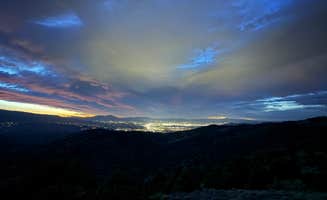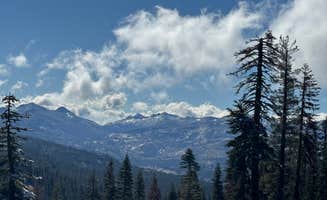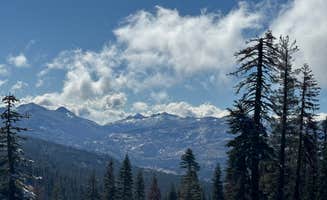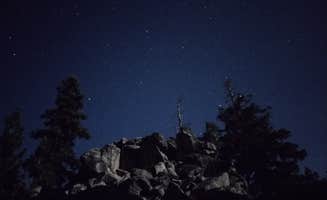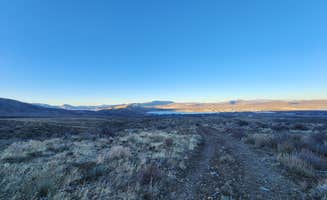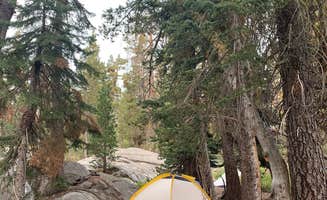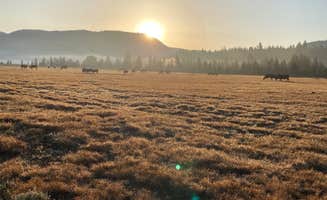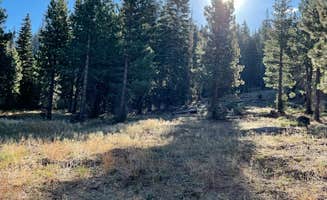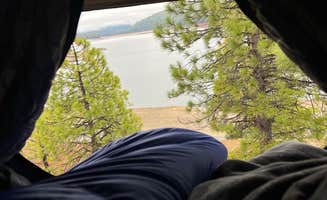Primitive camping near Incline Village-Crystal Bay, Nevada offers mostly high-elevation sites situated between 5,000-8,500 feet in the eastern Sierra Nevada range. The region experiences significant seasonal temperature variations, with summer highs averaging 75-85°F and nighttime temperatures dropping 30-40 degrees even in July and August. Most dispersed sites in this area follow standard Bureau of Land Management or Forest Service regulations limiting stays to 14 days.
What to do
Mountain biking trails access: Several dispersed camping areas serve as excellent basecamp locations for mountain biking enthusiasts. At Scotts Lake Rd Dispersed Camping, you can find routes suitable for different skill levels. "Easy to drive into just be careful of potholes and large puddles from rain, even in summer. No amenities, but it's a very beautiful area," notes Alex P.
Wildlife viewing opportunities: The surrounding forest lands contain diverse wildlife habitats. "There are herds of cows that will make their way through the area, please be respectful of them!" advises one camper at Scotts Lake Rd Dispersed Camping. Early morning and evening hours typically offer the best viewing times for native species.
Explore remote lakes: More adventurous campers can access highland lakes via rougher roads. "We went just up the road into the wildlife reserve and drove all the way up to burnside lake. Beautiful. Definitely need 4x4 and the road is super bumpy," reports Blair K. about areas beyond the main camping zones.
Visit historic sites: Kyburz Flats offers access to interpretive historical sites. One camper notes, "Road is rough, especially after first mile to interpretive site. Looks like a few spots there you could camp." These areas provide insight into the region's mining and settlement history.
What campers like
Night sky views: The relative distance from major light pollution sources makes stargazing exceptional at many sites. "I love the quietness of this spot and the view is wonderful!" shared Melissa B. about her experience at BLM - Water Tank Road Dispersed.
Peace and seclusion: Despite proximity to vacation communities, many sites offer isolation. "Dog Valley is my favorite quick escape from town. There are so many places to explore that it doesn't get old," explains Jake H. about Big Dog Valley.
Varied terrain access: The region offers both forest and open valley camping opportunities within short distances. "Dispersed camping not far from Lake Tahoe. Easy to drive into just be careful of potholes and large puddles from rain, even in summer," explains one camper about accessibility in the area.
Free camping options: Most dispersed sites have no fees. "It is a great site just near the road. We arrived on Monday afternoon and there were lots of places. There were other people but everyone has enough space," reports Rajesh N. about finding suitable free camping near Incline Village.
What you should know
Road conditions vary significantly: Access to many primitive campsites requires careful vehicle selection. At Granite Chief Wilderness - Dispersed, one camper reports, "Site looks beautiful but road turns from pavement to 4x4. Pulled over right after the pavement ended."
Seasonal closures and conditions: Higher elevation roads often close with first snowfall, sometimes as early as September. "It rained when we got here… which over night at some point turned into the first snow!!! How insanely beautiful!" reports Jakey and Alex L. about an unexpected weather change.
Development encroachment: Some previously established dispersed camping areas are being affected by expanding development. "This is a construction zone and I raised a lot of eyebrows by rolling through it. Couldn't find a campsite because the road was blocked by construction vehicles," warns a camper about changing access at one location.
Fire regulations change seasonally: Fire restrictions vary significantly based on conditions, location, and season. Not all dispersed sites permit fires, and regulations can change without notice during dry periods. Always check current fire regulations before planning camping that involves campfires.
Tips for camping with families
Select sites with natural boundaries: When camping with children, look for locations with natural area definitions. "There are a few sites about 4 miles back on an unmaintained road. The first turn off has the best view with somewhat flat ground for a tent," notes Don S. about Reno View Dispersed.
Watch for hazardous plants: Some areas contain thorny vegetation that can be problematic. "Views are unreal but would not suggest walking barefoot, tent camping or bringing dogs up here. The bottoms of our shoes looked like a warzone and when we laid down in our tents we were pricked by goatheads," warns Alex B.
Consider weather protection: Mountain weather changes rapidly, especially wind conditions. "It can be very windy but if you get between some of the trees it's not to bad," advises Tyler C. about finding sheltered camping spots in the region.
Toilet facilities are rare: Most dispersed camping areas have no bathroom facilities. One exception noted by a camper at Scotts Lake Rd: "There's a pit restroom which seems comparatively new." Pack appropriate supplies for sanitation at sites without facilities.
Tips from RVers
Careful road assessment recommended: RV drivers should thoroughly evaluate access roads before proceeding. At BLM FLATTOP, a visitor warns, "I tried driving up the other day, but couldn't make it due to rocks. The road starts out as a nice, easy fire road, gets a little rocky, and then by mile 6 or 7 it goes full blown rock garden."
Small trailers only: Most dispersed sites accommodate smaller RVs and trailers better than large rigs. "The dirt road was very rutted in a few areas," reported one visitor, highlighting the importance of appropriate vehicles.
Parking pad surfaces: Ground conditions at many sites consist of uneven, rocky surfaces. "Very rocky ground and a little windy so ground tents might be tough. RTT and campervans are perfect for this spot!" notes a camper about surface conditions at one location.
Self-contained systems necessary: With no hookups or dump stations available at dispersed sites, RVers must plan accordingly. "Large spaces and plenty of room for more than one vehicle per site," reports Michelle R. about space availability at one location.



